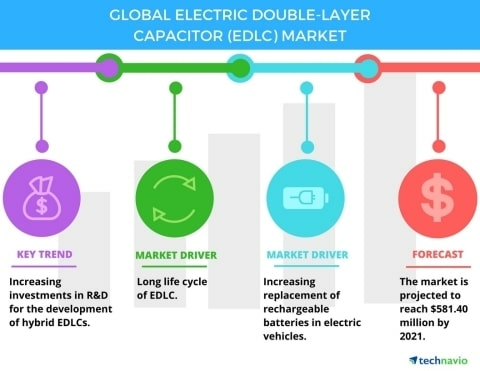source: business wire news
LONDON–(BUSINESS WIRE)–Technavio has announced the top seven leading vendors in their recent global electric double-layer capacitor (EDLC) market report. This research report also lists nine other prominent vendors that are expected to impact the market during the forecast period.
EDLCs have the energy storage properties of batteries and the power discharge characteristics of capacitors. The main reason for the rapid growth of the global EDLC market is the growing demand for compact and energy-efficient storage devices across the end-user segments. Electric vehicles, consumer electronics, power utilities, and transportation are some of the end-user segments of the market.
Competitive vendor landscape
The global EDLC market is fragmented with the presence of numerous vendors. The market is still in its nascent stage. The adoption of this technology is restricted to developed regions such as Western Europe and North America and a few countries of Asia like Japan, South Korea, and China. Vendors have started offering devices that use nontoxic electrolytes. This makes these devices nonflammable.
“Most vendors in the global EDLC market are well established in the batteries and energy storage devices industries. To capitalize this emerging technology, companies are investing heavily in their R&D. Especially, companies like Maxwell Technologies, Nippon Chemi-Con, Skeleton Technologies, and Panasonic have strong footholds in the market. Recently, Maxwell Technologies has doubled its production to address the increasing demand for its EDLCs in various segments of the market,” says Sunil Kumar Singh, a lead embedded systems research analyst from Technavio.
Top seven EDLC market vendors
Maxwell Technologies
Maxwell Technologies started as a government contractor, providing advanced physics, pulsed power, space effects analysis, and other R&D services to the US military and other government agencies. In the early 1990s, the company was converted into a commercial organization. Currently, it offers products for commercial applications and generates most of its revenue from this. It primarily focuses on commercializing EDLCs, high voltage capacitors, and microelectronic components and systems in the market.
Murata Manufacturing
Murata Manufacturing is primarily engaged in the electronic parts business. Electronic parts manufacture and sale: It is involved in the development, manufacture, and sales of electronic parts, including components for capacitors and piezoelectric products. It is engaged in staff welfare benefits, education training programs, manpower dispatching services, maintenance and cleaning of facilities services, leasing and management of real estate, development of software, and provision of contract analysis service of electronic parts.
Nesscap Energy
Nesscap Energy is a leading developer and manufacturer of EDLCs. It is partnered with Hyundai Motor, a global automotive manufacturer, to develop EDLCs for hybrid electric vehicles manufactured by Hyundai Motor. In addition, Nesscap Energy is well positioned to take advantage of the rapid market growth for EDLCs in nontraditional markets such as the market in China.
NEC TOKIN
NEC TOKIN manufactures electronic components and devices. The product portfolio of the company includes conductive polymers, tantalum capacitors, super capacitors, tantalum capacitors, and proadlizers. It also offers transformers, choke coils, EMI countermeasure parts, piezoelectric ceramics, piezoelectric inverters for cold cathode tubes, multilayer piezoelectric actuators, and flex suppressors.
Nippon Chemi-Con
Nippon Chemi-Con has developed various electronic components, starting from aluminum electrolytic capacitors. It has made various changes to adapt itself to the globalized environment and has developed new technologies in the electronics industry. It has a well-established presence across the globe.
Panasonic
Panasonic is involved in the manufacture of EDLCs that are used for power supply purposes in heavy applications. The group has its presence in the Americas, Europe, Japan, East Asia, South Asia, and Oceania. It is one of the group companies under Panasonic that is comprised of more than 680 companies involved in the manufacturing of electronic products.
Skeleton Technologies
Skeleton Technologies manufactures and develops EDLCs with high energy and power density. The company serves the transportation, automotive, industrial, and renewable energy markets and provides green and cost-effective storages to them. It also offers high-end carbon and adsorption materials.
featured chart source: Technavio































